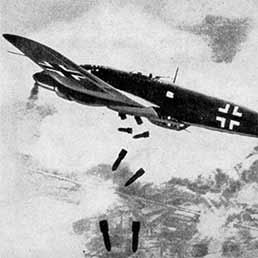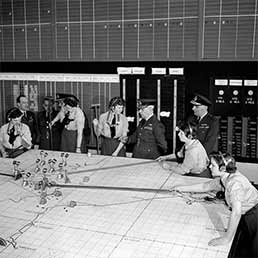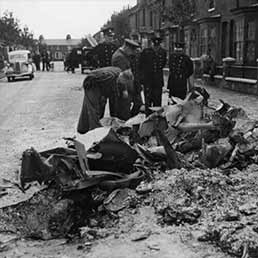Operations Block
The Operations Block, built in 1927, from where all air operations were controlled at Hawkinge during the war, is now home to many of the items gleaned from over 700 Battle of Britain aircraft, the majority of which were excavated by the Museum's recovery team in the late 1960s and 1970s together with those donated by individuals since the foundation of the collection.
Items large and small, ranging from aero engines to small strips of alloy with identification numbers of the aircraft concerned, all bear mute witness to the terrible force of their impact with the ground, some 80 years ago.
After each excavation the details of the crash are fully researched, and the recovered artefacts are cleaned, sorted and put on display. Whether it's a letter, a control column, an engine, instruments or just a few twisted fragments and some empty cartridge cases that are found, they each hold the key to unlock a story about an incident in the Battle of Britain. Each board is part of a large jigsaw that helps build up the story of the Battle. As you tour the Museum and read the displays, they will start to form an overview of the Battle, with first-hand accounts, photographs and tangible relics of those involved. In many cases the display of these artefacts are the only memorial that the pilot or airman in question may have, other than his gravestone, and, sadly, many never even had these.
In a number of cases you will see parts recovered from an aircraft that a pilot has shot down, only later to see items from an aircraft in which he, in turn, has been shot down. Sometimes they will have survived to fight another day, at other times they will have paid the ultimate price. Some of those whom you read about will have been shot down and killed on their first combat sortie, whilst others will have fought in the Spanish Civil War (on both sides), the battles of Poland, the Low Countries and France.
Some will have survived being shot down five or six times (some British pilots were shot down twice in one day). As well as British and German airmen, American, Australian, Belgian, Canadian, Czech, French, New Zealand, South African and Polish pilots are represented.
A note about one of the nationalities above:-
As many of our visitors will realize, in 1940 America was neutral, not declaring war on the Axis forces until the attack on Pearl harbour by the Japanese in December 1941. However, a number of young Americans felt the need to come to Britain's aid, and made the journey to the UK to volunteer for the RAF. Some claimed to be Canadian, others naming some other Commonwealth country as their home, despite a presidential proclamation making it illegal for any American citizen to join a warring power's military and also to "hire someone to go beyond the territorial limits of the United States –to Canada, for example –to enlist in a foreign country's military." During the Battle of Britain there were 11 Americans fighting alongside our pilots; one of these was John Kenneth Haviland. Many more followed them to fly in the newly formed "Eagle Squadrons" from 1940 -1941 when America joined the war. Sadly, John Haviland was the only Battle of Britain American pilot to survive the war and our Museum was honoured to receive him as a guest during the 50th Anniversary celebrations of the Battle in 1990.




